 Research Article
Research Article
Research, Development and Commercial Applications of Bioactive Seaweed Substances in Health Products
Yimin Qin*
State Key Laboratory of Bioactive Seaweed Substances, Qingdao, China
Yimin Qin, State Key Laboratory of Bioactive Seaweed Substances, Qingdao, China.
Received Date:January 25, 2021; Published Date: April 27, 2021
Abstract
Seaweeds are arguably, collectively the largest marine biomass and contain a wide range of bioactive substances with nutritional, pharmacological and other biological activities highly valuable in many potential industrial applications such as functional foods, nutraceuticals, pharmaceuticals, cosmetics, biomedical materials, fertilizers, etc. In these applications, the bio-compatible, non-toxic and hydrophilic nature of most bioactive substances derived from seaweed raw materials offer unique health benefits which are difficult to obtain with land-based substances, natural products or synthetic ingredients. With the advance of aquaculture technologies and the development of new efficient extraction techniques, seaweed-based bioactive substances have a broad scope for sustainable and environmentally friendly development with a high potential of economic utilization.
Keywords: Seaweeds; Natural products; Phyco chemicals; Secondary metabolites; Bioactivities
Introduction
Biomass is the term given to take the mass of living biological organisms in each area, or ecosystem, at a given time. Amongst the many varieties of micro-organisms, plants and animals that form the overall quantity of biomass on earth, marine biomass represents a relatively under-explored resource which has attracted considerable attention in recent years, partly because of the overexploitation of land-based resources. As the oceans cover more than 70% of the globe’s surface, ocean-based biomass and the related biomaterials are not only vast in quantity, they are also structurally diverse with many unique biological activities. With marine species comprising approximately one half of the total global biodiversity, the oceans offer an enormous resource for novel compounds [1-4].
The importance of marine biomass as a source of novel bioactive substances is growing rapidly. It is estimated that more than 20,000 new compounds have been isolated from marine biomass, with a wide range of applications from pharmaceutical products to functional foods [5]. Different kinds of substances have been procured from marine biomass because marine environment gives marine organisms unique genetic structures and life habitats, opening the door to the development of many more novel bioactive substances that can be utilized in food, beverage, medicine, biotechnology, cosmetics, textiles, etc [6,7].
Seaweeds are important marine organisms and their commercial applications date back to ancient times. In China, where homology of medicine and food has been recognized over 2000 years, the health benefits of seaweeds were recognized in ancient medicinal books such as Sheng Nong’s Herbal Classic, Supplementary Records of Famous Physicians, Marine Herbal, Compendium of Materia Medica, etc [8]. Seaweed based fertilizers were also used in Britain and France over a long time ago. Modern science and technology have uncovered the many bioactive seaweed substances and allowed their separation and purification into high valued bio-products, which are now widely used in a wide range of health-related industries [9,10].
Seaweed biomass
Seaweeds, or marine macro algae, are quantitatively the largest biomass in the ocean [11,12]. The term algae refer to a large and diverse assemblage of organisms that contain chlorophyll and carry out oxygenic photosynthesis, among which, marine algae are those found in the ocean, including micro algae, which are generally single cell species, and macro algae, which include brown, red and green seaweeds. In 2009, global output of a brown seaweed Saccharina japonica was 4.9 million tons, while that of Undaria pinnatifida was 1.7 million tons. Among the red seaweeds, the output for carrageenophytes Kappaphycus alvarezii and Eucheuma spp, both known as “Cottonii” was 4.8 million tons, while that of the red agarophytes of the genus Gracilaria, was 296,000 tons [13]. The output for the red Pyropia spp, valuable as food alga “Nori”, was 1.6 million tons. It is estimated that the Norwegian coastal water contains 50-60 million tons of seaweed biomass, with 7 million tons washed on shore each year.
Although there are huge varieties of natural seaweeds, worldwide research and commercial exploration are mainly focused on ten genera or species, i.e. Laminaria sp, Fucus sp, Ascophyllum nodosum, Chondrus crispus, Pyropia spp, Ulva sp, Sargassum sp, Gracilaria sp, Palmaria palmate, Undaria pinnatifida, etc [14]. Whilst there are large quantities of wild resources for these types of seaweeds, commercial exploration is now mainly from cultivated sources. As can be seen in Figure 1, China is by far the largest seaweed cultivator in the world, with about 50% of the global output [13]. These natural and cultivated seaweeds are a unique source of raw materials for the production of seaweedbased bio-products. They have large scale and varieties, and are green, environmentally friendly and renewable. In general, seaweed biomass and the natural products derived from them are hydrophilic, biocompatible and biodegradable, and contain many substances with high bioactivities, which are important supplement to land based resources [15,17] (Figure 1).
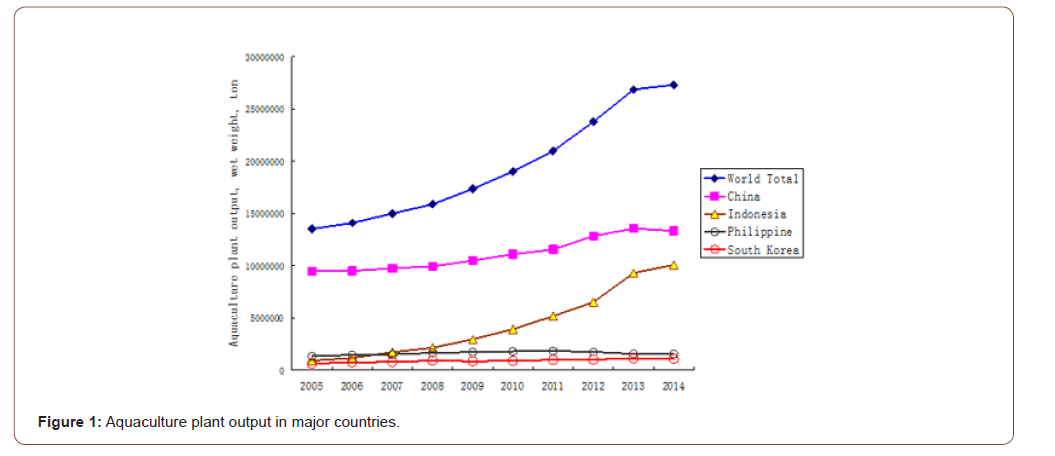
Bioactive seaweed substances
Bioactive seaweed substances (here abbreviated as BASS) are a group of chemical components extracted from seaweed biomass, which can influence the biological processes of living organisms through chemical, physical, biological and other mechanisms. These substances include biomass components in the extracellular matrix, cell wall, plasma and other parts of the seaweed cells generated through primary and secondary metabolism, of which, the primary metabolites are generated when the seaweed cells process nutrients through bio-degradation or bio-synthesis, such as amino acids, nucleotides, polysaccharides, lipids, vitamins, etc, while secondary metabolites are those chemicals modified from primary metabolites, including genetic materials, medicinal materials, biotoxins, functional materials and other seaweed based substances. Figure 2 illustrates the major components in a plant cell. Similar to a normal plant cell, the seaweed cells can be divided into cell wall, protoplast, ergastic substances and physiological activators. These are substances that possess high bioactivities and commercial values when separated, extracted and purified [18,19] (Figure 2).
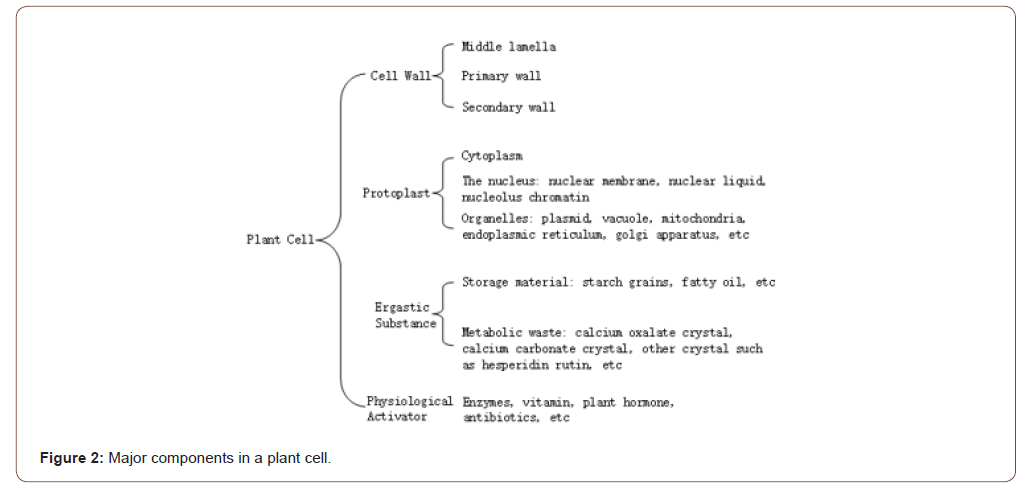
Table 1:

(Table 1) shows the cell composition of brown, red and green seaweeds. The three types of seaweeds have long been used to produce alginate, agar and carrageenan, which are natural polymeric materials with very large molecules capable of dissolving in water to give viscous solutions. As water-soluble carbohydrates, these biopolymers are used to thicken aqueous solutions, to form gels of varying degrees of firmness, to form water-soluble films, and to stabilize some products, such as ice cream where they inhibit the formation of large ice crystals so that the ice cream can retain a smooth texture. In addition to alginate, carrageenan and agar, seaweeds also contain many substances in smaller quantities but with much high and specific bioactivities. Based on their roles in the seaweed cell, these many bioactive seaweed substances can be divided into structural components such as alginate, carrageenan and agar, physiological substances such as the many halogenated chemicals evolved as part of the defense mechanism for seaweeds, and metabolic compounds such as β-carotene, astaxanthin, eicosapentaenoic acid, etc.
According to their chemical structures, they can be divided into polysaccharides, polypeptides, amino acids, lipids, sterols, terpenoids, glycosides, non-peptide nitrous compounds, enzymes, pigments, and other chemical species with defined chemical structures. According to their bioactivities, they include many substances with anti-tumor, immune regulation, blood sugar reduction, radiation resistance, reduction of hematic fat, anticoagulant, antithrombotic, anti-inflammatory, anti-allergic, antibacterial, antiviral, oxidation resistance, resistance to UV radiation, inhibition of enzyme activities, anti-aging, anti-HIV, deodorant, fatigue resistance and many other functions [20,21].
The commercial exploration of the many bioactive seaweed substances have now developed into an environmentally friendly and sustainable industrial chain, comprising seaweed cultivation, extraction of bioactive substances, purification & modification, and commercial applications of the seaweed derived bio-products. While traditionally used in textile, printing, animal feeds, fertilizers, and other traditional industries, with the application of advanced technologies, the value of bioactive seaweed substances can be further increased in many emerging high valued applications. For example, alginate extracted from brown seaweeds can be converted into fibers through a wet spinning process, while the fibers can be further made into nonwoven fabrics and converted into highly absorbent wound dressings. During this process, the sales of alginate based, products derived from each ton of brown seaweed increased from RMB 8,000/t for raw seaweeds to RMB16,000/t for sodium alginate, RMB80,000/t for alginate fibers, and RMB 2,400,000/t for alginate wound dressings respectively.
Technical problems in the research and development of bioactive seaweed substances
The development of bioactive seaweed substances involves three major technical activities, i.e., extraction and purification of seaweed components, functional modifications and commercial applications of the various types of seaweed based, materials. Over the years, many processes have been developed to extract chemicals from seaweeds, such as iodine, alginate, fucoidan, etc from brown seaweeds, carrageenan and agar from red seaweeds [15]. Purity is a major issue for these biomass derived substances, especially for high end applications in the biomedical and pharmaceutical industries, where endotoxin, glycoprotein and other impurities may initiate inflammatory responses, hence sophisticated purification processes are required. Functional modifications of bioactive seaweed substances are also important in further enhancing the value and widening the applications of these materials. In this respect, while natural seaweed derived substances already offer a wide range of chemical structures and material properties, through physical, chemical and biological modifications, the range of structures and properties can be further extended to offer more specific functional performances.
It should be pointed out that in this relatively new field, there remain many scientific and technical problems. In particular, the following areas still require a vast amount of research and development efforts. First, the dehydration and drying operations need to be more efficient in order to save fresh water and energy. Bioactive seaweed substances are highly hydrophilic materials which require a vast amount of fresh water to separate them from the rest of the seaweed biomass. For example, almost 1000 tons of fresh water is required to produce 1 ton of alginate. A systematic research into the separation, dehydration and drying processes is useful to cut back the water and energy requirement of the production process.
Second, as natural compounds, bioactive seaweed substances are chemically and physically connected with various other components of the seaweed biomass. The production of high purity products requires detailed research into the impurities complexed with the various bioactive seaweed substances. Third, more work is required to generate derivatives from bioactive seaweed substances. This is important to generate more functional properties, widen applications, and generally increase the value of seaweed biomass. Fourth, the complex structures of natural compounds need sophisticated characterization techniques. Fifth, as the bioactive seaweed substances possess many novel bioactivities, studies need to be carried out to qualify and quantify these performances in vitro and in vivo, so that the mechanisms of their clinical benefits are clearly understood. Last but not least, a large number of standards and test methods are required for the many types of bioactive seaweed substances.
Applications of bioactive seaweed substances
(Figure 3) shows an illustration of the commercial applications of seaweeds. While traditionally used as a marine vegetable, seaweeds are increasingly used for their rich contents of bioactive substances, with the production of phycolloids totaling more than 100,000 tons globally [22]. In recent years, the many bioactivities of seaweed derived substances have found applications in functional foods, drug and health products, cosmetics, biomedical materials, fertilizers and environmental protection areas. They can benefit human health through their many unique bioactivities. Some of these applications are introduced below.
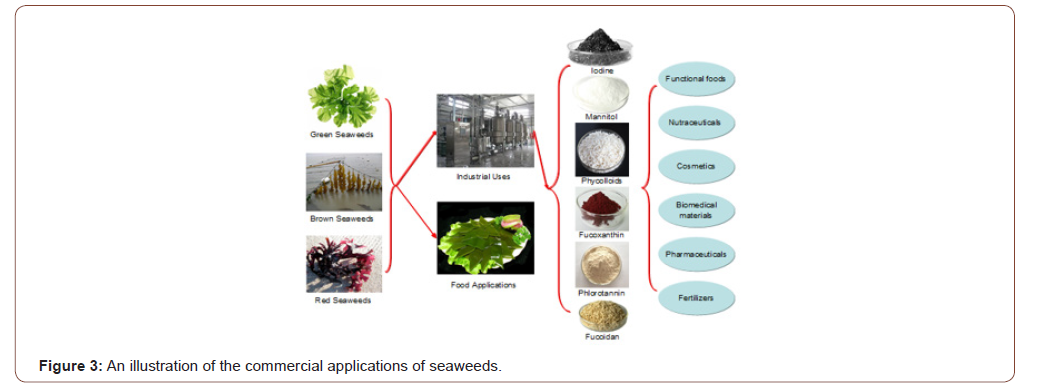
Marine functional foods
Seaweed derived hydrocolloids have long been used as food ingredients. In particular, the unique biophysical properties of alginate and carrageenan are highly valuable in the development of functional food products [23]. As food ingredients, the applications of alginate and carrageenan are based on three main properties, i.e., thickening, gelling and film forming. In particular, the unique gelling abilities at low temperature alongside good heat stability make alginate ideal for use as thickeners, stabilizers and restructuring agents. Recently, alginate is increasingly used in a myriad of newer applications, from encapsulating active enzymes and live bacteria, to acting as the carrier for protective coating of pre-packed, cut or prepared fruits and vegetables. With novel chemical and biological modifications to alter its structures and properties, there are possibilities of novel applications of specific alginates in the food industry that have high bioactivities at low concentrations. In general, seaweed derived functional foods can provide health benefits by reducing the risk of chronic diseases and enhancing the ability to manage chronic diseases, thus improving the quality of life. They can also promote growth and development and enhance performance [14].
Marine nutraceuticals
Marine nutraceuticals can be derived from a vast array of sources, including marine plants, microorganisms, and sponges. Fucoidan is a complex fucose-rich sulphated carbohydrate which can be extracted from brown seaweeds. This biologically active carbohydrate has been shown to inhibit a wide range of cancer cell lines and studies in mice indicate that anti-cancer effects are seen in-vivo too [24]. As a marine nutraceutical product, fucoidan has been used in many health products and is important for its high bioactive properties, for example, antibacterial, anticoagulant, antiviral, antitumor, etc [25-27]. Seaweeds and marine micro algae are natural sources for β-carotene, astaxanthin and eicosa pentaenoic acid (Figure 4 for their chemical structures), which have high bioactivities and are important part of nutraceutical products, playing a significant role in a number of aspects of human health (Figure 4).
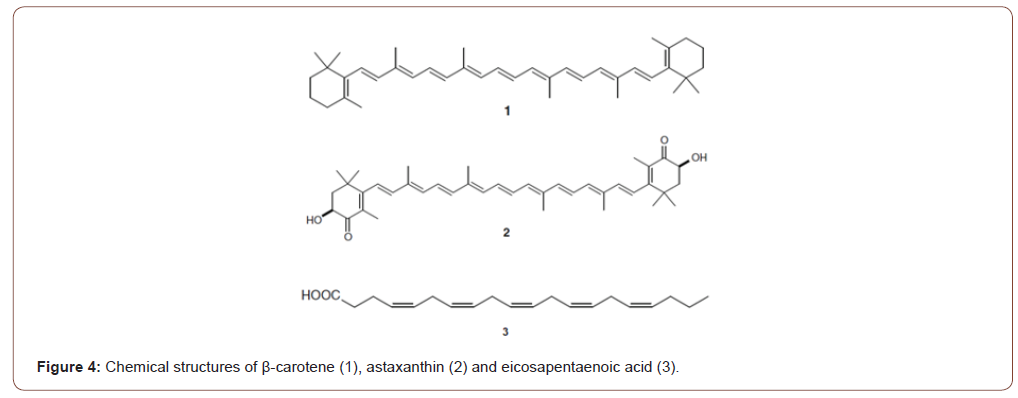
Marine drugs and health products
It has been shown that seaweeds contain compounds that may have anti-cancer, anti-tumor, anti-viral activity and other pharmacological activities [28]. Many reports have been published about isolated compounds from seaweeds with biological activities, demonstrating their ability to produce metabolites that can be used for marine drugs and health products. In this respect, daily consumption of seaweed has been proposed as a factor in explaining lower post-menopausal breast cancer (BC) incidence and mortality rates in Japan [29] where the average consumption of seaweeds is much higher than the rest of world. Natural products derived from seaweeds are both a fundamental source of a new chemical diversity and an integral component of today’s pharmaceutical collection. Nowadays, numerous marine compounds are isolated from marine animals, algae, fungi, and bacteria with antibacterial, anticoagulant, antifungal, antimalarial, antiprotozoal, antituberculosis, and antiviral activities. In the last three decades, the discovery of metabolites with biological activities from macro algae has increased significantly. Substances that currently receive most attention from pharmaceutical companies for use in drug development, or from researchers in the field of medicine-related research include sulphated polysaccharides as antiviral substances, halogenated furanones from Delisea pulchra as antifouling compounds, and kahalalide F from a species of Bryopsis as a possible treatment of lung cancer, tumours and AIDS. Other substances such as macro algal lectins, fucoidans, kainoids and aplysia toxins are routinely used in biomedical research and a multitude of other substances have known biological activities. There are huge potential for seaweed based bioactive substances in pharmaceutical, medicinal and research applications [30]. The many medicinal benefits of bioactive seaweed substances include their anti-herpes simplex virus type 1 activity antibiotic Citation: Yimin Qin. Research, Development and Commercial Applications of Bioactive Seaweed Substances in Health Products. Annal of Pub Health & Epidemiol. 1(4): 2020. APHE.MS.ID.000516. Page 6 of 9 activity [31], bioactivity against acne vulgaris [32], anti-obesity property [33], inhibition of lipase activity [34], anticancer activity [35], enzyme inhibition [19], hepatoprotective effect [36], antiinflammatory activity [37], etc.
Marine cosmetics
In recent years, cosmeceuticals of natural origin are becoming more popular than synthetic cosmetics. Hence, the investigation of new seaweed derived functional components has become a promising area of cosmeceutical studies. Chemical constituents isolated from diverse classes of seaweeds exert a wide range of nutritional, functional and biological activities, which make these unique metabolites of seaweeds potential ingredients of high-class cosmetic products. For example, brown seaweeds produce a range of active components including unique secondary metabolites such as phloro tannins, many of which have specific biological activities. In cosmetic applications, brown seaweed derived active compounds have shown various functional properties including antioxidant, anti-wrinkling, whitening, anti-inflammatory and anti-allergy, which are biological effects closely associated with cosmeceutical preparations [38] (Figure 5).
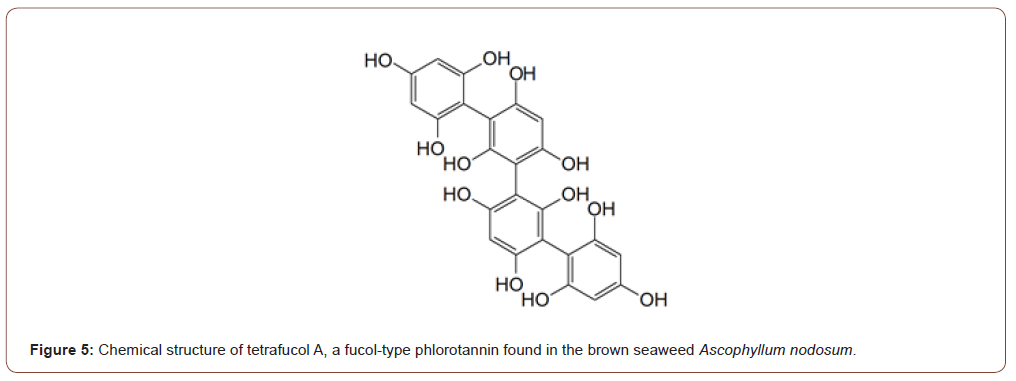
Marine biomedical materials
Much attention has been paid to marine derived biomaterials for various biological, biomedical, and environmental applications. Marine bioactive substances for healthcare are the most important and fastest growing sector among marine biomaterials. Seaweeds are the abundant source for polysaccharides such as alginate, agar, agarose, and carrageenan, of which, alginate is a biomaterial that has found numerous applications in biomedical science and engineering due to its favorable properties, including biocompatibility and ease of gelation. Alginate hydrogels have been particularly attractive in wound healing, drug delivery, and tissue engineering applications, as these gels retain structural similarity to the extracellular matrices in tissues and can be manipulated to play several critical roles. Alginic acid can combine with many types of metal ions to form fibrous materials containing a high concentration of metal ions, enabling the fibers to have flame retardant and magnetic wave shielding properties. Calcium alginate fibers also possess unique gel forming capabilities when the calcium ions exchange with sodium ions in body fluid. As shown in Figures 6&7 nonwoven fabrics made from alginate fibers can form a soft hydrogel when on contact with body fluid, a property highly valuable in wound dressings, face masks, absorbent pads and other medical and hygiene textile materials [39-41] (Figure 6).

Marine fertilizers
(Figure 7) Seaweeds contain many growth promoting substances in addition to many organic and inorganic matter that can improve the physical and chemical nature of soil [42,43]. In terms of soil structure, seaweed does not add a great deal of bulk, but its jelly like alginate content helps to bind soil crumbs together, and it contains nitrogen, phosphorous and potassium compounds in addition to various amino acids and other important soil nutrients. In the modern seaweed processing industry, seaweed fertilizers have become a fast growing sector where residues from the extraction processes can be utilized to serve as high quality soil fertilizers. Fresh seaweeds can be processed for foliar feeding or root zone applications through drip lines with soluble extracts. Seaweeds, particularly bladderwrack, kelp or laminaria, can be either applied to the soil as a mulch or can be added to the compost heap, where it is an excellent activator.

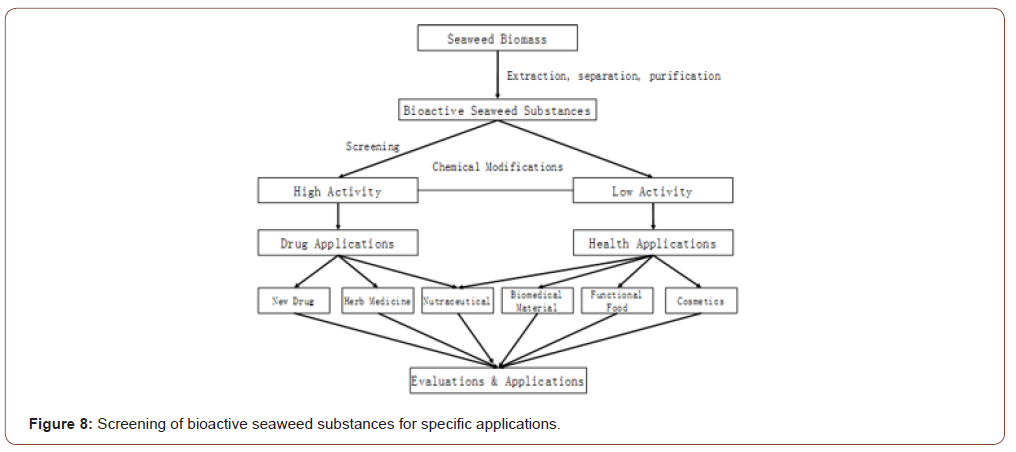
Future perspective
Seaweed biomass represents a vast amount of structurally diverse natural resources [44,45]. They are versatile products widely used for food in direct human consumption, also as ingredients for the global food and cosmetics industries, as fertilizers and as animal feed additives. Because of the many highly bioactive substances, seaweeds are now increasingly used as a source for drugs, nutraceuticals and other high valued products [28,46-49] (Figure 8).
Looking into the future, bioactive seaweed substances are valuable in a group of industries including pharmaceuticals, nutraceuticals, functional foods, biomedical materials, cosmetics, fertilizers, in addition to traditional applications in textiles, chemicals and environmental protection. Once extracted, separated and purified, the various types of bioactive seaweed substances can be screened for their bioactivities and utilized in an appropriate application. Figure 8 illustrates the screening of bioactive seaweed substances for specific applications.
Summary
In summary, the seaweed biomass contains many varieties of bioactive substances which are highly valuable in a number of health-related industries. Modern technologies can allow the separation of these native ingredients into purified chemical compounds. Once structurally characterized and functionally assessed, the highly active compounds can be applied in marine drugs, while those with lower activities can be used in herb medicine, nutraceuticals, biomedical materials, functional foods and other applications based on the level of their bioactivities.
Acknowledgement
None.
Conflict of Interest
No conflicts of interest.
References
- Charette M, Smith WHF (2010) The volume of earth’s ocean. Oceanography 23(2):112-114.
- Gage JD, Tyler PA (1991) Deep-sea biology: a natural history of organisms at the deep-sea floor. Cambridge University Press, Cambridge.
- Steele JH (1985) A comparison of terrestrial and marine ecological systems. Nature 313: 355-358.
- Pietra F (2002) Biodiversity and natural product diversity. Pergamon Press, Amsterdam.
- Hu Y, Chen J, Hu G, Yu J, Zhu X, et al. (2012) Statistical research on the bioactivity of new marine natural products discovered during the 28 years from 1985 to 2012. Mar Drugs 13(1): 202-221.
- Thakur NL, Thakur AN (2006) Marine biotechnology: an overview. Indian J Biotechnol 5: 263-272.
- Kim SK (2015) Handbook of marine biotechnology. New York.
- Xia B, Abbott IA (1987) Edible seaweeds of China and their place in the Chinese diet. Economic Botany 41(3): 341-353.
- Zemke-White WL, Ohno M (1999) World seaweed utilisation: An end-of-century summary. J Appl Phycol 11: 369-376.
- Das D (2015) Algal biorefinery: An integrated approach. New York.
- Nedumaran T, Arulbalachandran D (2015) Seaweeds: a promising source for sustainable development. In: Thangavel P, Sridevi G (Eds.), Environmental sustainability. India.
- Chapman RL (2013) Algae: the world’s most important “plants” - an introduction. Mitig Adapt Strateg Glob Change 18: 5-12.
- FAO (2016) Fishery and Aquaculture Statistics 2014. FAO, Rome.
- Holdt SL, Kraan S (2011) Bioactive compounds in seaweed: functional food applications and legislation. J Appl Phycol 23: 543-597.
- Ioannou E, Roussis V (2009) Natural products from seaweeds. In: Osbourn AE, Lanzotti V (Eds.), Plant-derived natural products. Springer Science Business Media, LLC.
- McHugh DJ (2003) A guide to the seaweed industry. FAO Fisheries Technical Paper 441. FAO, Rome.
- Tseng CK (2004) The past, present and future of phycology in China. Hydrobiologia 512: 11-20.
- Bondu S, Bonnet C, Gaubert J, Deslandes É, Turgeon SL, et al. (2015) Bioassay-guided fractionation approach for determination of protein precursors of proteolytic bioactive metabolites from macroalgae. J Appl Phycol 27: 2059-2074.
- Olivares-Molina A, Fernández K (2016) Comparison of different extraction techniques for obtaining extracts from brown seaweeds and their potential effects as angiotensin I-converting enzyme (ACE) inhibitors. J Appl Phycol 28: 1295-1302.
- Conde E, Moure A, Domínguez H (2015) Supercritical CO2 extraction of fatty acids, phenolics and fucoxanthin from freeze-dried Sargassum muticum. J Appl Phycol 27: 957-964.
- Nomura M, Kamogawa H, Susanto E, Kawagoe C, Yasui H, et al. (2013) Seasonal variations of total lipids, fatty acid composition, and fucoxanthin contents of Sargassum horneri (Turner) and Cystoseira hakodatensis (Yendo) from the northern seashore of Japan. J Appl Phycol 25: 1159-1169.
- Bixler HJ, Porse H (2011) A decade of change in the seaweed hydrocolloids industry. J Appl Phycol 23: 321-335.
- Imeson A (1997) Thickening and gelling agents for food. Blackie Academic and Professional, London.
- Lowenthal RM, Fitton JH (2015) Are seaweed-derived fucoidans possible future anti-cancer agents. J Appl Phycol 27: 2075-2077.
- Bakunina KM, Sova I, Ermakova V, Kuznetsova S, Besednova T, et al. (2008) Structure, biological activity, and enzymatic transformation of fucoidans from the brown seaweeds. Biotechnol J 3(7): 904-915.
- Zhu Z, Zhang Q, Chen L, Ren S, Xu P, et al. (2010) Higher specificity of the activity of low molecular weight fucoidan for thrombin-induced platelet aggregation. Thromb Res 125(5): 419-426.
- Li B, Lu F, Wei X, Zhao R (2008) Fucoidan: structure and bioactivity. Molecules 13(8): 1671-1695.
- Murphy C, Hotchkiss S, Worthington J, McKeown SR (2014) The potential of seaweed as a source of drugs for use in cancer chemotherapy. J Appl Phycol 26: 2211-2264.
- Teas J, Vena S, Cone DL, Irhimeh M (2013) The consumption of seaweed as a protective factor in the etiology of breast cancer: proof of principle. J Appl Phycol 25(3): 771-779.
- Smit AJ (2004) Medicinal and pharmaceutical uses of seaweed natural products: A review. J Appl Phycol 16: 245-262.
- Fernandes DRP, de Oliveira VP, Yoneshigue Valentin Y (2014) Seaweed biotechnology in Brazil: six decades of studies on natural products and their antibiotic and other biological activities. J Appl Phycol 26: 1923-1937.
- Kok JML, Jee JM, Chew LY, Wong CL (2016) The potential of the brown seaweed Sargassum polycystum against acne vulgaris. J Appl Phycol 28: 3127-3133.
- Awang AN, Ng JL, Matanjun P, Sulaiman MR, Tan TS, et al. (2014) Anti-obesity property of the brown seaweed, Sargassum polycystum using an in vivo animal model. J Appl Phycol 26: 1043-1048.
- Chater PI, Wilcox M, Cherry P, Herford A, Mustar S, et al. (2016) Inhibitory activity of extracts of Hebridean brown seaweeds on lipase activity. J Appl Phycol 28: 1303-1313.
- Ermakova SP, Menshova RV, Anastyuk SD, Zakharenko AM, Thinh PD, et al. (2016) Structure, chemical and enzymatic modification, and anticancer activity of polysaccharides from the brown alga Turbinaria ornata. J Appl Phycol 28: 2495-2505.
- Chale-Dzul J, Moo-Puc R, Robledo D, Freile-Pelegrín Y (2015) Hepatoprotective effect of the fucoidan from the brown seaweed Turbinaria tricostata. J Appl Phycol 27: 2123-2135.
- McCauley JI, Meyer BJ, Winberg PC, Ranson M, Skropeta D (2015) Selecting Australian marine macroalgae based on the fatty acid composition and anti-inflammatory activity. J Appl Phycol 27: 2111-2121.
- Wijesinghe WAJP, Jeon YJ (2011) Biological activities and potential cosmeceutical applications of bioactive components from brown seaweeds: a review. Phytochem Rev 10: 431-443.
- Qin Y (2008) The gel swelling properties of alginate fibers and their application in wound management. Polymers for Advanced Technologies 19(1): 6-14.
- Qin Y (2005) The ion exchange properties of alginate fibers. Textile Research Journal 75(2): 165-168.
- Qin Y (2006) The characterization of alginate wound dressings with different fiber and textile structures. Journal of Applied Polymer Science 100(3): 2516-2520.
- Zhang Y, Han JY, Mu J, Feng Y, Gu XJ, et al. (2013) Bioactivity and constituents of several common seaweeds. Chin Sci Bull 58(19): 2282-2289.
- Rebours C, Marinho-Soriano E, Zertuche-González JA, Hayashi L, Julio A Vásquez, et al. (2014) Seaweeds: an opportunity for wealth and sustainable livelihood for coastal communities. J Appl Phycol 26(5): 1939-1951.
- Blunt JW, Copp BR, Keyzers RA (2009) Marine natural products. Nat Prod Rep 26(2): 170-244.
- Hill RA (2012) Marine natural products. Annu Rep B (Organ Chem) 108: 131-146.
- Xu N, Fan X, Yan X, Tseng CK (2004) Screening marine algae from China for their antitumor activities. J Appl Phycol 16: 451-456.
- Jiménez-Escrig A, Gómez-Ordóñez E, Rupérez P (2012) Brown and red seaweeds as potential sources of antioxidant nutraceuticals. J Appl Phycol 24: 1123-1132.
- Qin Y, Li K, Zhang J (2019) Functional Marine Food Ingredients. Beijing: China Light Industry Press.
- Qin Y, Zhang Q, Liang H (2020) Functions and Applications of Fucoidan. Beijing: China Light Industry Press.
-
Yimin Qin. Research, Development and Commercial Applications of Bioactive Seaweed Substances in Health Products. Annal of Pub Health & Epidemiol. 1(4): 2021. APHE.MS.ID.000516.
-
Seaweeds, Natural products, Phyco-chemicals, Secondary metabolites, Bioactivities, Cosmetics, Biomedical materials, Fertilizers, Cottonii, Biodegradation, Biosynthesis, Protoplast, Ergastic Substances, Physiological Activators, Alginate, Carrageenan, Agar, Antithrombotic, Anti-Inflammatory, Anti-Allergic, Antibacterial, Antiviral, Oxidation resistance
-

This work is licensed under a Creative Commons Attribution-NonCommercial 4.0 International License.






